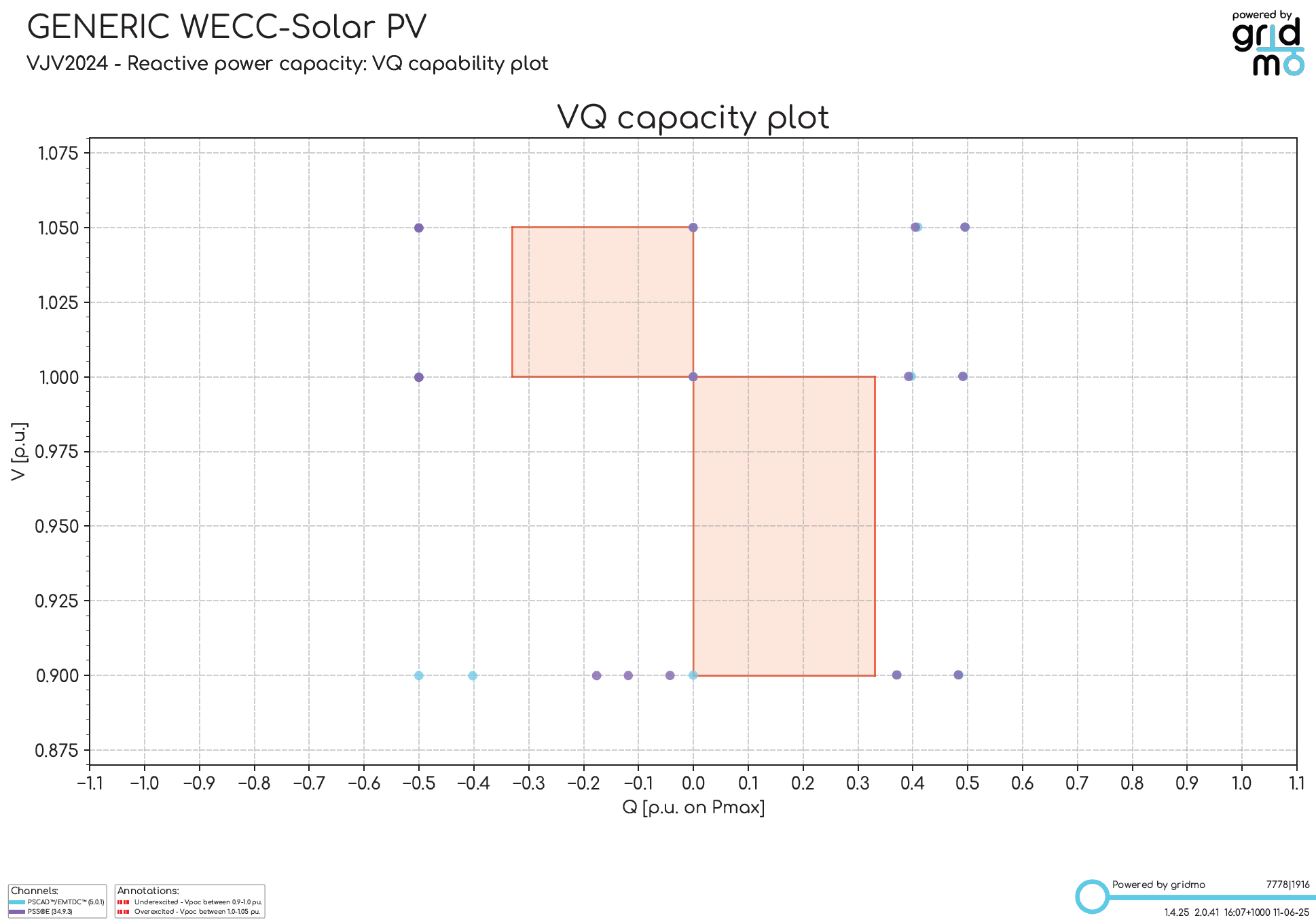Template: Fingrid Grid Code Specifications for Power Generating Facilities (VJV2024)

Template version: v1
Country:

FI
Software required:
Source: VJV2024 - Grid Code Specifications for Power Generating Facilities (15 Jan 2025)

Before running this template, complete the following:
- Configure your Global Variables and Scenario Variables using gridmo's Model setup template.
- Add this template to your project.
Changes required before first run
- PSS®E Static Nodes
1826,1830,1836,1840,1912,2056: Change the referenceGEN=999#1to the bus and ID of the equivalent Thévenin voltage source in your PSS®E model. - PSS®E Dynamic Nodes
2519&2523: AddCONTROLcommands to set the power generating facility's Q(V) voltage droop slope to 4%. An example has been provided in the Nodes. - PSCAD™ Nodes
2521&2525: AddSETcommands to set the power generating facility's Q(V) voltage droop slope to 4%. An example has been provided in the Nodes.
Changes recommended prior to submission
- PSS®E Dynamic Nodes
1827,1829,1837,1839: Change the simulation time from180.5seconds to1800.5seconds. These PSS®E Nodes have a shorter simulation time so you can test the short-term frequency withstand capability of your generator without waiting a long time for the simulation to complete. - PSS®E Dynamic Nodes
1871,2491: Change the simulation time from180seconds to3610seconds. These PSS®E Nodes have a shorter simulation time so you can test the short-term voltage withstand capability of your generator without waiting a long time for the simulation to complete.
Background
Fingrid's VJV2024 'Grid Code Specifications for Power Generating Facilities' outline the technical requirements for connecting generation to the Finnish power system. The specifications distinguish between 4 categories of generation (type A, B, C, D) determined by the supplied power and voltage of the generator's connection point, with specific requirements for synchronous generators and converter-connected power park modules (inverter based generation).
This template covers the specifications for power park modules which are classified as type D generators, i.e., their connection point voltage is at least 110 kV OR their rated capacity (Pmax) is at least 30 MW. If your generator is not type D, this template still covers specifications which may be relevant but some parts may not be applicable as they are type D only.
- The technical requirements for connecting energy storage to the Finnish power system are outlined in Fingrid's SJV2024 grid code specifications, which are not covered in this template.
- This template only covers tests for specifications of power park modules (asynchronous generation) from Sections 16-18, in addition to the general requirements in Section 10. Tests for specifications of synchronous power generating modules (Sections 11-15) are not yet included.
The table below summarises the 9 gridmo Runs provided in this template and the equivalent sections of VJV2024 they correspond to.
| Runs | Relevant Section(s) of VJV2024 |
|---|---|
| Operating frequency and voltage capability | 10.5.2 - Operating voltage and frequency range of the power generating facility 10.3.3 & 10.5.5 - Overvoltage withstand capability |
| Reactive power capacity | 17.2.1 - Reactive power capacity requirement 17.2.4 - Reactive power capacity calculation |
| Reactive current supply | 18.1.2 - Reactive current supply by a power park module |
| Fault ride-through capability | 10.3.4 - Recovery of active power after a voltage disturbance 10.5.3 - Fault ride-through capability 10.5.4 - Calculation of the operation of the power generating facility during voltage disturbance |
| Frequency control | 10.2.2 - Rate of change of frequency withstand capability 10.2.3 - Limited frequency-sensitive mode – over-frequency (LFSM-O) 16.3.3 - Implementation of active power control and frequency control |
| Active power control | 10.2.4 - Active power control 16.2.1.1 - Minimum output 16.3.4 - Rate of change of active power 16.3.6 - Rapid down-regulation of active power |
| Voltage control | 18.2.2 - Constant voltage control |
| Reactive power control | 18.2.3 - Constant reactive power control |
| Power factor control | 18.2.4 - Constant power factor control |
Configuration
Operating frequency and voltage capability
The purpose of these tests is to confirm your power generating facility's ability to operate in a range of voltage and frequency ranges, in accordance with Section 10.5.2 and Figure 10.7.
- Tests are conducted at infinite SCR and X/R.
- Tests are conducted at a range of generating levels, i.e. Pmin (5% of rated capacity), Pmax, Q=0, Qmax and Qmin.
- All frequency 'steps' are completed at a 2 Hz/s ramp rate, in accordance with Section 10.2.2.
- The over-voltage withstand capability test includes the more severe momentary overvoltage from Figure 10.4, in accordance with Sections 10.3.3 & 10.5.5.
Reactive power capacity
The purpose of this test is to identify your power generating facility's reactive power capacity in accordance with Section 17.2.1 and Figure 17.1.
The power generating facility is initialised at P=Q=0 at the POC and then instructed to ramp to a P,Q value in accordance with the reactive power capacity calculation operating points provided in Table 17.1 in Section 17.2.4.
- Tests are conducted at infinite SCR and X/R.
Reactive current supply
The purpose of these tests is to confirm your power generating facility's ability to supply fast reactive current across a range of voltage disturbances, within the performance thresholds (i.e. rise time, settling time) outlined in Section 18.1.2 and Figure 18.5.
The power generating facility is initialised at Pmax and Q=0, Qmax and Qmin at different levels of voltage disturbances to determine the reactive current supply (Iq injection) curve.
- The test for determining the reactive current injection curve is conducted at infinite SCR and X/R.
- The test for determining the rise time and settling time is done in the normal SCR and X/R range.
- All voltage disturbances are balanced faults of duration 250 ms to align with Table 10.3 in Section 10.5.4.
- The settling time requirement for reactive current states a tolerance of '+20% to -10%'. It is not clear which direction these tolerances apply to. We assume that the +20% tolerance is in the direction of the reactive current response due to the disturbance, and the -10% tolerance is in the opposite direction.
Fault ride-through capability
The purpose of these tests is to confirm your power generating facility's ability to continue operating during and after voltage disturbances, in accordance with Section 10.5.3.
The power generating facility is initialised at Pmax and Q=0, with Vpoc = 1.0 pu and faults applied as specified in Table 10.3 and Figure 10.10.
- Tests are conducted at minimum SCR and X/R.
- Checks for the recovery of active power after a voltage disturbance (Section 10.3.4) are included in Analysis Node
2662.
- VJV2024 states that the fault ride-through requirements are applicable to asymmetrical faults as well as symmetrical faults. However, this template only tests the power generating facility's performance for symmetrical faults to allow for benchmarking between PSS®E and PSCAD™. Unbalanced fault tests can be added to this template (only for PSCAD™) if requested.
- Section 10.4.3 states that the power generating facility should not 'disconnect as a result of several consecutive voltage disturbances'. To demonstrate this, we have included consecutive fault ride-through tests in the style of AEMO's Dynamic Model Acceptance Tests (DMAT) as VJV2024 does not clearly define the type of tests to perform. Hence the results of this test do not imply that your power generating facility has passed/failed the consecutive fault ride-through requirement for VJV2024, but it has been provided as an example of fault ride-through performance.
Frequency control
The purpose of this test is to confirm your power generating facility's active power response to power system frequency changes, in accordance with Sections 10.2.2, 10.2.3 and 16.3.3.
Section 10.2.3 states that 'when LFSM-O is active, its setpoint will prevail over any other active power setpoints'. This has been tested by applying a frequency disturbance to activate LFSM-O operation, then giving an active power reference command to observe if the generator reaches the setpoint.
- The test for determine the P(f) droop curve is conducted at infinite SCR and X/R.
- Tests are conducted using a playback generator with infinite inertia.
- Tests for demonstrating LFSM-U priority have not been included as most typical converter based generating systems (wind, solar) are not able to increase active power in response to under-frequency events.
Active power control
The purpose of this test is to confirm your power generating facility's ability to control active power at the connection point according to a target value, in accordance with Sections 10.2.4, 16.3.4 and 16.3.6.
- Test is conducted in the normal SCR and X/R range.
- Checks for the minimum active power output (Section 16.2.1.1) are included in Analysis Node
2510. - Checks for the rate of change of active power test (Section 16.3.4) are included in Analysis Node
2673.
- It is assumed that the intention of the rapid-regulation test (Section 16.3.6) is demonstrate that rapid decrease of active power for your power generating facility is possible. We have assumed that your power generating facility can achieve this using an active power reference command or similar. This test uses an active power command of Pref=0 and checking if the active power (at POC) is less than 20% of Pmax 5 seconds after the reference command is given.
Voltage control
The purpose of this test is to confirm your power generating facility's ability to control the voltage at the connection point, in accordance with Section 18.2.2.
- The tests for determining the power generating facility's Q(V) droop characteristic are conducted at infinite SCR and X/R.
- The tests for determining the power generating facility's performance (i.e. rise time, settling time) are conducted in the normal SCR and X/R range.
- VJV2024 requires the performance calculation test to be conducted by setting the power generating facility's slope to 4% droop. This needs to be configured manually in Nodes
2521,2525,2519and2523usingSETandCONTROLcommands.
Reactive power control
The purpose of this test is to confirm your power generating facility's ability to control the reactive power delivered at the connection point according to a target value, in accordance with Section 18.2.3.
- Test is conducted in the normal SCR and X/R range.
Power factor control
The purpose of this test is to confirm your power generating facility's ability to control the power factor at the connection point, in accordance with Section 18.2.4.
- Test is conducted in the normal SCR and X/R range.
Assumptions
- We assume that the term 'short-circuit power' = Minimum 3PH synchronous fault level. Note that our templates uses the
$min_SCRand$max_SCRGlobal Variables where SCR = (Minimum 3PH synchronous fault level / project rated active power). - For tests which are confirming parameters which only affect a final settled value (e.g. Q(V) droop characteristic parameters, P(f) droop characteristic parameters, and Iq injection characteristic parameters), the tests are conducted at infinite SCR to simplify the test methodology and interpretation of results. For tests which are confirming parameters which may affect transient dynamic performance (e.g. fault ride-through capability and performance), the tests are conducted in the normal SCR range (minimum and maximum SCR).
- Section 10.4.5: Power Quality - Tests for power quality or harmonics assessment are not currently supported.
- Sections 10.4.4, 10.4.8, 16.2.1.2 - These specifications require tests demonstrating protection relay operation. These are not included within this template as they are not commonly modelled in PSS®E/PSCAD™.
Sources
Revision history
Version 1 | 20 June 2025
- First release.